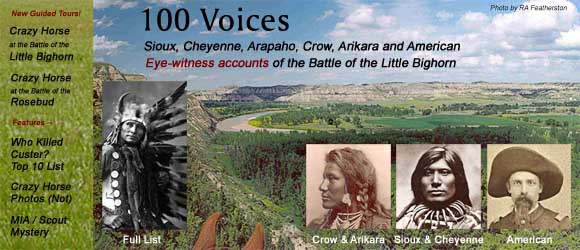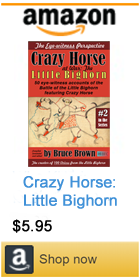|
||||||||||
Bruce Brown's 100 Voices... 'The Revenge of Rain-in-the-Face' In that desolate land and lone, "Revenge!" cried Rain-in-the-Face, In the meadow, spreading wide In his war paint and his beads, Into the fatal snare The sudden darkness of death But the foemen fled in the night, Whose was the right and the wrong?
The two primary accounts of the battle by Rain In The Face are very different, and frankly contradictory. The first (actually the second chronologically) by Santee Sioux Ohiyesa is sympathetic and respectful -- essentially a death bed conversation between two old friends -- while the second by American journalist W. Kent Thomas is glibly exploitive -- Thomas purportedly got Rain In The Face drunk to induce him to tell his tale. Yet both accounts sound like the same man talking, and they both have something to contribute, even if they contradict each other at many important turns. For instance, in the Ohiyesa version, Rain In The Face identified an Anonymous Youth (who was subsequently slain) as Custer's killer, while in the Thomas version, he said no one knew who killed Custer -- "it was like running in the dark." In the Thomas version, Rain In The Face said he cut out his old nemesis Tom Custer's heart and spit it in his face, while in the Ohiyesa version he denied the whole Tom Custer battlefield episode -- "many lies were told about me." Even so, the Battle of the Little Bighorn story most closely associated with Rain In The Face is probably still the famous poem by Henry Wadsworth Longfellow,"The Revenge of Rain-in-the-Face," which features Rain In The Face cutting out Tom Custer's heart in "revenge" for his abusive treatment of Rain In The Face at Ft. Lincoln the year before, witnessed by Frank Huston, who saw Tom Custer "kick and slap Rain while troopers held him." Historically speaking, Longfellow's poem is steeped in misconception. For starters, neither Custer nor his men were carrying sabers (as Rain In The Face correctly recalled in the W. Kent Thomas interview). More importantly, Seventh Cavalry surgeon Dr. H.R. Porter, who examined the corpses the day after the battle, said neither George nor Tom Custer's heart was not cut out (although Charles Roe, who was on the burial detail after the battle, disagreed). Furthermore, based on the eye-witness record, it appears that Oglala Sioux war chief Little Horse or Minneconjou Sioux warrior Lazy White Bull were more likely Tom Custer's killer. Nonetheless, Rain In The Face was a force at the Battle of the Little Bighorn. Ohiyesa said Rain In The Face was a leader of the Indians' first counter-charge against Reno, which forced the American troopers to abandon their defensive line in the open and fall back to the timber along the river. Thunder Bear called Rain In The Face the bravest man in the battle. Little Knife said the Rain In The Face was the only Indian who took a Seventh Cavalry prisoner during the battle. -- Bruce Brown The Concise Encyclopedia of the American Indian by Bruce Grant with illustrations by Lorence F. Bjorklund, Gramercy 1989
|
||||||||||












